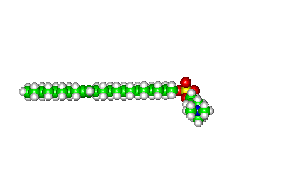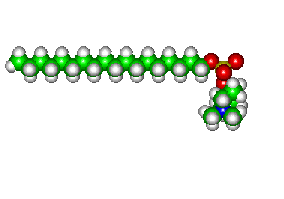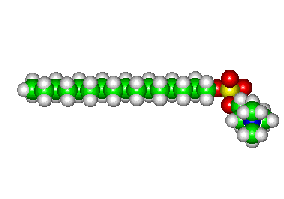Cancer Poster Session
| INABIS '98 Home Page | Your Session | Symposia & Poster Sessions | Plenary Sessions | Exhibitors' Foyer | Personal Itinerary | New Search |
Introduction
Alkylphosphocholines (APC) represent a new-fashioned group of non-DNA-interactive substances with a wide spectrum of biological effects such as [1-4]:
- cytotoxicity against tumor cells in vitro and in vivo;
- inhibition of neoplastic cell invasion in normal tissues;
- modulation of phospholipid metabolism;
- induction of differentiation in malignant cells;
- activation of cytotoxic macrophages;
- interference with different steps of signaling pathways.
The cytotoxic and mitogenic effect of APC have been tested on a number of murine and human cell lines in attempts to determine the spectrum of tumors sensitive to them. Among the APC sensitive lines are: MDA-MB-231 and MCF-7 human mammary-gland derived cell lines, 1/C2 and 1/C32 rat mammary-carcinoma lines,HL-60, Jurkat, U-937, HAT-29 and KB human gastrointestinal tract-derived cell lines and many others [5,6 and others]. Some other tumor lines have been considered as resistant to APC - colorectal adenocarcinoma CXF 1103, renal cancer RXF 423, colon carcinoma T84 and others [7,8].
The synthesis of various derivatives of APC family is an area of an intensive research - the mechanism of action of APC is not yet clear and it has been suggested that there are some differences in the spectrum of biological effects between the family members [8].
The aim of this study was to test the effects of hexadecylphosphocholine (HPC), arucylphospho-N,N,N-trimethylpropanolamine (EPC3) and octadecyl-(1,1-dimethyl-4-piperidylio)phosphate (ODPP) on some melanomas as a model system for solid tumors.
Materials and Methods
Chemicals
|
All alkylphosphocholines were donated kindly from Dr. M.R. Berger (DKFZ, Heidelberg).
|
|
|
|
|
Cis- diamminedichloroplatinum II (CDDP) was obtained from Sigma. The compounds were more than 99% pure, stored at 4C degree in tightly closed tubes. Stock solutions were prepared in RPMI 1640 medium, distributed in test tubes, and stored at -20C degree.
Cells and culture media
Cell lines were obtained from the American Type Culture Collection. B16-F1-melanoma culture was retrieved from a tumor bearing mouse. All cells were maintained in RPMI 1640 medium supplemented with 10% fetal calf serum, L-glutamine, sodium pyruvate and antibiotics, at 37C degree in a humidified 5% CO2 -95% air atmosphere.
U-937 and Jurkat cell lines were treated as suspension cultures, while SK-MEL-1, SK-MEL-5 and B16-F1 grown in adhesion cultures and were APC dosed after 24 h adhesion. Melanoma cell lines were harvested after detaching with 0.1% trypsin - 0.005% EDTA following procedure known in the art. All lines were passaged three times a week.
MTT assay
MTT solution (10 microliters 5 mg/ml PBS) was added to 100 microliters cell culture and the plates were incubated for 4 h under cell culturing conditions. Solubilization solution (100 microliters 10% SDS in 0.01 M HCl) was then added to each well to dissolve the formazan crystals. After 24 h the absorbtion at 580 nm was measured.
Apoptosis assay by DNA fragmentation
Cells were harvested, centrifuged and resuspended in 100 microliter digestion buffer containing 100 mM NaCl; 10mM Tris-HCl, pH8.0; 25mM EDTA, pH8.0; 0.5% SDS and 0.1 mg/ml proteinase K. After 24 h incubation with gentle shaking at 34C degree the samples were subjected to phenol-chloroform extraction and precipitated at -20C degree by the addition of 10 microlilter of 2.5M sodium acetate, pH5.2, and 200 microliter of absolute ethanol. The precipitated DNA was resuspended in 50 microliter of TE buffer and loaded onto agarose gel. Agarose gel electrophoresis was carried out using 1.2% agarose gel in 40mM Tris-acetate buffer, pH 8.5, containing 2mM EDTA at 40V for 2h.
Results
IC50 determination
Before IC50 determination, several points were checked out:
- the melanoma cells grown on glass coverslips were fixed and inspected for phenylalanin synthesis with Fontana reaction;
- the cell culturing conditions were tested for “saturation” culturing different cell densities for different times;

- the biological activity of tested compounds was inspected under well known conditions with popular cell lines - U937 and Jurkat (Table);
- the best curve-fitting model was chosen after r and SD comparison.
Because of the obvious cell overgrow and medium exhaust after prolong culturing, cellular “surviving” was determined with MTT-assay after 48 houres cultivation. MMF curve-fitting model was used and IC50 values were established. The results are summarized in the following table where the evaluation is given by means and standard deviation:
|
EPC3 |
ODPP |
HPC |
|
|
B16-F1 |
87.1± 15.9 |
90.2± 2.4 |
112.3± 8.4 |
|
SK-Mel-1 |
27.0± 8.9 |
36.8± 7.4 |
80.3± 9.0 |
|
SK-Mel-5 |
75.0± 12.7 |
107.3± 11.4 |
108.6± 5.9 |
|
U-937 |
21.4± 2.2 |
13.4± 5.4 |
23.8± 3.5 |
|
Jurkat |
not tested |
not tested |
38.5± 8.1 |
Combination of HPC with cisplatina
B16-F1-melanoma culture grown to reach confluent layer was exposed for 48 h to a range of concentrations of HPC, EPC3, ODPP in combination with different concentrations of cisplatina. Toxicity was dose-related with respect to cisplatina, but APC tested demonstrated both cytotoxic and mitogenic activity. In general the results did not show a synergistic effect of the both drugs. (Each point is the mean of 3-4 determinations. Blue circles designates the sole effect of cisplatina.)



Morphologic changes
After exposure with APC there was distinct vacuolization in U-937 line. Under the same conditions some B16 cells have not adhered to the surface of the wells. The cells were not flat but rounded, the vacuols were big and translucent in contrast to the small dense granules observed normally.
The search under light microscopy revealed that APC-treated melanoma cells didn’t exhibit morphological features consistent with apoptosis - there were no marked cellular condensation and fragmentation of nuclei.
DNA-degradation
|
Exposure of melanoma cells to HPC for 48 h resulted in dose dependent (2 - 10 uM HPC; 3 - 20 uM HPC; 4 - 40 uM HPC; 5 - 80 uM HPC) gradual DNA degradation(1 - untreated control; M - DNA marker). There was no ladder-like fragmentation visible in the samples obtained from all cells in the culturing well.
|
|
|
As a result of an incubation with HPC there were both adhered and floating melanoma cells. So, DNA was extracted separately and agarose gel electrophoresis was carried out. Again the intranucleosomal fragmentation pattern was not observed in the samples - there were high molecular DNA in adherent cells (B) and random degradated DNA in floating cells (T). Similar results were obtained in independent experiments.
|
|
Discussion and Conclusion
In 1993 Trulla et al. [9] tested the cytotoxic effects of two APC (ET180Me and BM 41.440) on three variants of murine melanoma B16 cell line. It has been suggested that cytotoxic activity depends on the cellular metabolism, the contents of membrane cholesterol, the endogeneous ether-lipids level. That is the reason to test stringently our culturing conditions and cell density.
When B16-F1 was treated for 48 h, HPC, ODPP and EPC3 have approximately equal IC50 values. Similar IC50 values have been obtained for two SK-MEL lines. Cell lines with hematopoetic origin - Jurkat and U-937 were much more sensitive to a treatment with APC.
There is still no accepted mechanism of APC action. Although APC are known to induce apoptosis in some lines [5], it seems unlikely that the programmed cell death could play a significant role in this case. There was no evidence of apoptotic cell death in our experiments. Morphological changes and electrophoretical results would better suggest membrane damage.
The toxicity of APC is quite different form that of other antineoplastic drugs [10] and there are many reasons to look for a combination chemotherapy with standard drugs like cisplatina.
Combined application of APC tested and cisplatina to melanoma B16-F1 does not lead to better cytotoxic effect in the initial experiments. They show that the incubation of cells with quite a little doses of APC results in a decrease in the sensitivity to cisplatina. It has been suggested that the well documented mitogenic activity of APC is based on the stimulation of growth factor release and probably that is one explanation of our results. Further studies with reference to higher doses of both drugs and duration of incubation are needed.
References
- Berkovic, D. at al. Eur. J. Cancer 1994, 30a:509-515
- Hoffman D., Hoffman L. and Snyder F. Cancer Res. 1986, 46:5803-5809.
- Modolell M. et al. Cancer Res. 1979, 39:4681-4686.
- Zheng B. et al. Cancer Res. 1990, 50:3025-3031.
- Konstantinov S., Eibl H. and Berger R. Cancer Chemother. Parmacol. 1988, 41:210-216.
- Sobottka S., Eibl H. and Berger R. Int. J Cancer 1993, 53:418-425.
- Erukulla R. et al. J Med. Chem. 1996, 39:1545-1548.
- Koufaki M. et al. J Med. Chem. 1996, 39:2609-2614.
- Trulla L. et al. Lipids 1993, 5:403-406.
- Muschiol C. et al. Lipids 1987, 22:930-934.
Acknowledgments: We are grateful to Mrs. Netzeva (Department of Organic Chemistry, Medical University, Sofia) for provision of chemical formulas.
| Discussion Board | Previous Page | Your Poster Session |




